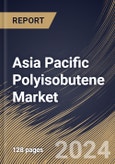The Asia Pacific Polyisobutene Market would witness market growth of 5.8% CAGR during the forecast period (2023-2030). In the year 2021, the Asia Pacific market's volume surged to 333.46 Kilo Tonnes, showcasing a growth of 4.9% (2019-2022).
Polyisobutene's inert nature and adhesive properties make it suitable for certain applications in the food packaging industry. It is used in adhesives for packaging materials, ensuring proper sealing and protection of food products. In the cosmetics and personal care industry, this is an emollient, contributing to the smooth and soft texture of products such as lipsticks, lotions, and creams.
Polyisobutene is used as an antistatic agent in the textile industry. It helps reduce textiles' static electricity, preventing clinginess and discomfort. PIB is employed as a base oil in the production of synthetic lubricants. Its properties enhance the lubricating capabilities of the final product, providing superior performance compared to traditional mineral-based lubricants.
The smooth application and mixing of foundation and concealer products in Japan can be attributed to the texture-enhancing its effects. It helps create a uniform and long-lasting finish, meeting the high standards of the Japanese cosmetics industry. Therefore, due to the above-mentioned factors, the market will grow significantly in this region.
The China market dominated the Asia Pacific Polyisobutene Market by Country in 2022 and would continue to be a dominant market till 2030; thereby, achieving a market value of $359.2 million by 2030. The Japan market is registering a CAGR of 5.1% during (2023 - 2030). Additionally, The India market would showcase a CAGR of 6.4% during (2023 - 2030).
Based on Molecular Weight Type, the market is segmented into High, Medium, and Low. Based on Application, the market is segmented into Lubricant Additives, Adhesives & Sealants, Automotive Rubber Components, Fuel Additives, and Others. Based on countries, the market is segmented into China, Japan, India, South Korea, Singapore, Malaysia, and Rest of Asia Pacific.
Polyisobutene's inert nature and adhesive properties make it suitable for certain applications in the food packaging industry. It is used in adhesives for packaging materials, ensuring proper sealing and protection of food products. In the cosmetics and personal care industry, this is an emollient, contributing to the smooth and soft texture of products such as lipsticks, lotions, and creams.
Polyisobutene is used as an antistatic agent in the textile industry. It helps reduce textiles' static electricity, preventing clinginess and discomfort. PIB is employed as a base oil in the production of synthetic lubricants. Its properties enhance the lubricating capabilities of the final product, providing superior performance compared to traditional mineral-based lubricants.
The smooth application and mixing of foundation and concealer products in Japan can be attributed to the texture-enhancing its effects. It helps create a uniform and long-lasting finish, meeting the high standards of the Japanese cosmetics industry. Therefore, due to the above-mentioned factors, the market will grow significantly in this region.
The China market dominated the Asia Pacific Polyisobutene Market by Country in 2022 and would continue to be a dominant market till 2030; thereby, achieving a market value of $359.2 million by 2030. The Japan market is registering a CAGR of 5.1% during (2023 - 2030). Additionally, The India market would showcase a CAGR of 6.4% during (2023 - 2030).
Based on Molecular Weight Type, the market is segmented into High, Medium, and Low. Based on Application, the market is segmented into Lubricant Additives, Adhesives & Sealants, Automotive Rubber Components, Fuel Additives, and Others. Based on countries, the market is segmented into China, Japan, India, South Korea, Singapore, Malaysia, and Rest of Asia Pacific.
List of Key Companies Profiled
- Lanxess AG
- BASF SE
- Berkshire Hathaway, Inc.
- Reliance Industries Limited
- INEOS Group Holdings S.A.
- Braskem SE (Odebrecht S.A)
- ENEOS Corporation (Eneos Holdings)
- Exxon Mobil Corporation
- Chevron Oronite Company LLC
- TPC Group
Market Report Segmentation
By Molecular Weight Type (Volume, Kilo Tonnes, USD Billion, 2019-2030)- High
- Medium
- Low
- Lubricant Additives
- Adhesives & Sealants
- Automotive Rubber Components
- Fuel Additives
- Others
- China
- Japan
- India
- South Korea
- Singapore
- Malaysia
- Rest of Asia Pacific
Table of Contents
Chapter 1. Market Scope & Methodology
Chapter 2. Market at a Glance
Chapter 3. Market Overview
Chapter 4. Asia Pacific Polyisobutene Market by Molecular Weight Type
Chapter 5. Asia Pacific Polyisobutene Market by Application
Chapter 6. Asia Pacific Polyisobutene Market by Country
Chapter 7. Company Profiles
Companies Mentioned
- Lanxess AG
- BASF SE
- Berkshire Hathaway, Inc.
- Reliance Industries Limited
- INEOS Group Holdings S.A.
- Braskem SE (Odebrecht S.A)
- ENEOS Corporation (Eneos Holdings)
- Exxon Mobil Corporation
- Chevron Oronite Company LLC
- TPC Group
Methodology

LOADING...








